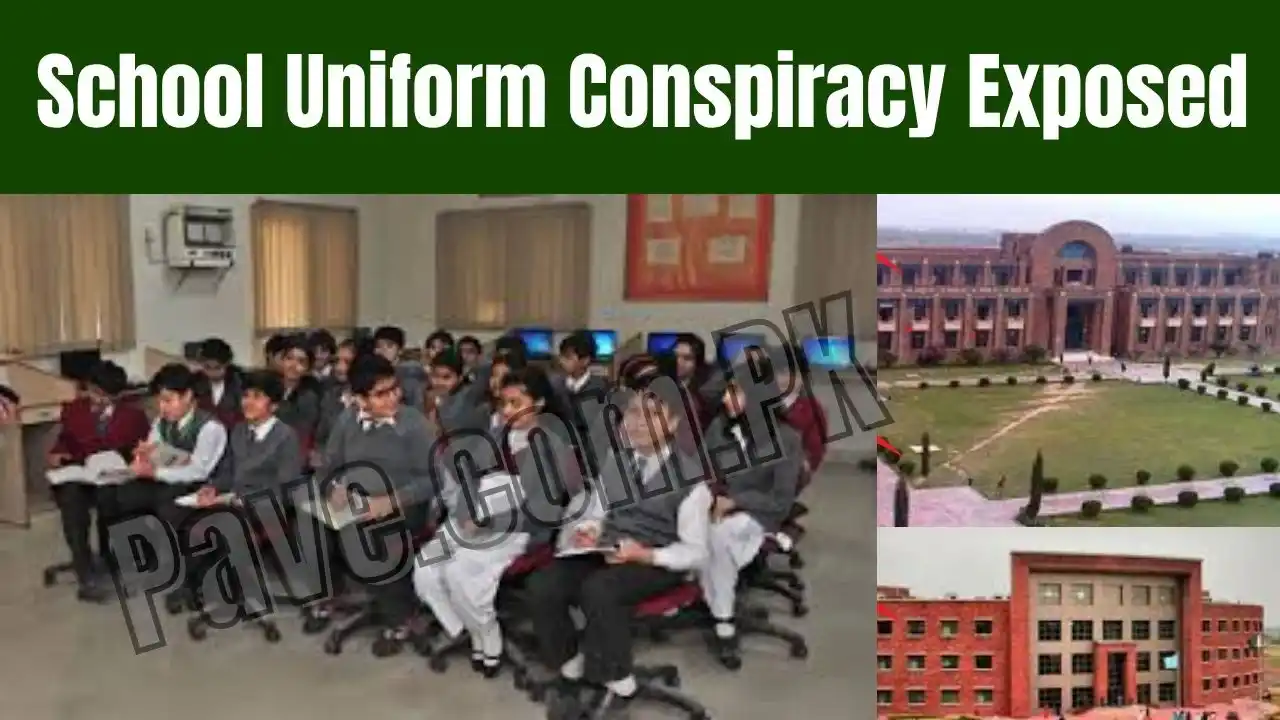School Uniform Conspiracy Exposed – Shocking Facts You Didn’t Know
School uniforms have been a globally accepted tradition for decades. Parents, teachers, and school owners often argue that uniforms promote discipline, equality, and school identity. But what if the real reasons behind this deeply rooted system are far more complex than we’re told? Over the past few years, education experts, parents, and social critics have started to question the hidden motives behind compulsory uniforms. As we dig deeper into history, economics, psychology, and marketing, an uncomfortable truth begins to emerge — school uniforms may not be as innocent as they seem.School Uniform Conspiracy Exposed
Children across the world spend thousands of hours wearing the exact same outfits, following strict dress codes, and being punished for minor violations. While schools claim uniforms are essential for discipline, more research suggests that uniforms could be tools of control, profit, and even subtle social conditioning. Parents are forced to buy specific color schemes, expensive badges, and branded garments only from authorized vendors — often at inflated prices. This raises a simple question: Who really benefits from school uniforms? Spoiler alert: it’s not always the students.
In this article, we expose the lesser-known truths, business interests, and psychological tactics hidden behind the school uniform culture — truths people rarely discuss openly.
🧵 The Business Behind School Uniforms
One of the biggest secrets behind school uniforms is the huge commercial profit linked to them. Many private schools partner with:
- Specific uniform shops
- Fabric manufacturers
- Tailors under contract
These partnerships ensure the school gets a share of the profit by forcing parents to purchase exclusively from “school-approved” vendors. This monopoly eliminates cheaper alternatives and increases uniform prices significantly.
It’s not unusual to see uniforms costing more than average market clothing — even though the fabric quality is often not premium. In some cases, parents must replace uniforms yearly due to “updated designs,” generating repeat sales.
Uniforms are often promoted as tools for discipline, but beneath the surface, they subtly influence identity and social perception. Psychologists argue that clothing significantly affects how individuals think, behave, and interact. When every student wears the same uniform, the message becomes clear: blend in, don’t stand out, and follow the collective mindset.
Read Also: PSL 11 to Be Played in Six Cities Across Pakistan 2025
Over time, this repeated conditioning shapes personality traits such as:
- Reduced willingness to challenge authority
- Higher acceptance of hierarchy
- Lower tendency to question systems
Many critics warn that this early-stage conditioning trains students to be compliant workers rather than independent thinkers. Traditional schooling already emphasizes obedience, and uniforms amplify this through external control. Some sociologists even compare uniform policies to industrial-era factory models — designed to train children to follow instructions, ignore self-expression, and prioritize productivity over creativity.
Beyond mental conditioning, uniforms influence social invisibility. Without personal fashion, unique identity markers vanish, making every child look identical. In theory, this reduces judgment, but in reality, it can suppress individuality and natural self-expression that children need during developmental stages. Kids learn to seek approval based on conformity rather than talent or personality, which can harm self-esteem in the long run.
Additionally, uniform enforcement often leads to discriminatory discipline. Students from wealthier families can afford multiple uniforms, while those with worn-out clothing are judged and sometimes bullied. Schools, instead of fostering empathy, unintentionally reinforce class bias hidden under the idea of “neatness.”
Modern education experts suggest a balance: allow personal choice with modest guidelines rather than strict uniform rules. This approach promotes identity, comfort, creativity, and confidence — while still maintaining respect and order on campus.
💸 The Hidden Financial Pressure on Parents
Uniforms are marketed as cost-saving, but statistics disagree.
Parents often spend money on:
- Multiple shirts/pants
- Seasonal sweaters/jackets
- School-branded socks
- Sports kits
- Ties and belts
- Shiny school shoes
This cost can easily exceed regular clothing expenses. For low-income families, this becomes a financial burden and leads to social embarrassment for children whose uniforms appear old or faded.
🧠 Uniforms and Social Conditioning
Psychologists suggest that uniforms instill:
- Obedience to authority
- Group identity over individuality
- Conformity in appearance
While discipline can be positive, critics argue that early conditioning might:
- Kill creativity
- Reduce self-expression
- Make children more passive to social control
This raises ethical questions about how schools may indirectly condition young minds to fit predetermined molds.
🎭 Does Equality Argument Really Work?
Schools often claim uniforms eliminate:
- Fashion competition
- Class divide
- Bullying over outfits
However, studies show:
- Wealthy students still differentiate through watches, shoes, backpacks, and smartphones.
- Bullying simply adapts to new targets:
- Accent
- Skin tone
- Grades
- Social background
Uniforms don’t magically erase inequality; they sometimes hide it under a blanket of forced sameness.
🤫 The Psychological Conspiracy of ‘Order’
Uniforms help maintain control.
Why?
Because identical clothing:
✅ Reduces individuality
✅ Makes crowds predictable
✅ Simplifies discipline
✅ Reinforces hierarchy
When everyone looks the same, it becomes easier for authority to manage behavior.
This mirrors military dress codes — another system designed for behavioral compliance.
Read Also: Qatar Injects $3B Into Pakistan Economy 2025 Deal
🧥 Seasonal Discomfort & Health Concerns
Many uniforms are:
- Too thick for summer
- Too light for winter
- Uncomfortable fabric
- Poor ventilation
Sweating, rashes, and respiratory infections are common among students wearing inappropriate seasonal attire. But schools seldom change uniform policies due to:
- Tradition
- Contract commitments
- Profit agreements
🪧 Punishment Culture & Dress Code Policing
Uniform violations lead to:
- Detentions
- Written warnings
- Suspension
- Public humiliation
This teaches children that appearance matters more than academic performance and personal development.
Imagine receiving harsher punishment for sock color than homework negligence — that’s the disturbing reality.
🧶 Color Psychology – Intentional or Coincidental?
School uniforms often use:
- Navy Blue – evokes discipline and obedience
- Grey – reduces emotional expression
- Brown – symbolizes seriousness
These color choices can subtly impact mood, energy, and mindset. Coincidence? Maybe not.
🛍️ Uniform Shops – A Quiet Cartel
Ever wonder why:
- Only one shop sells your school’s uniform?
- Prices increase yearly?
- Quality remains average?
- Accessories must be school-branded?
These signs hint toward commercial partnerships where schools earn commissions per sale — parents rarely know.
🧩 Loss of Identity and Creativity
When every student wears the same thing, children lose:
- Individual style
- Personal confidence
- Cultural expression
School becomes an assembly line — producing identical “products.”
Read Also: PIA Restarts UK Flights After 5 Years — Islamabad to Manchester
👨👩👦 Parental Pressure & Social Competition
Parents fear that:
- Non-brand uniforms symbolize poverty
- Torn uniforms indicate bad parenting
Society builds unnecessary pressure around appearances instead of values.
📚 Alternative Systems That Work Better
Countries like:
- Finland
- Netherlands
- Switzerland
have no uniforms, yet score extremely high in:
✅ Creativity
✅ Personal development
✅ Academic performance
Because learning matters more than dress codes.
🏫 Schools Defending Themselves: Their Arguments
To be fair, schools argue:
- Uniforms promote discipline
- Reduce clothing stress
- Increase school identity
- Avoid fashion bullying
Some benefits are valid — but do they outweigh the hidden negatives?
🧾 The Real Question We Must Ask
Are school uniforms truly:
- Helping education?
OR - Supporting commercial interests?
Do they promote:
- Equality?
OR - Psychological control?
These are conversations parents rarely question.
🏁 Conclusion
The conspiracy behind school uniforms is not about fabric — but about power, profit, and psychological conditioning. Parents have been conditioned to accept uniforms as mandatory for quality education without questioning the logic behind them. Meanwhile, uniform shops enjoy exclusive contracts, schools collect commissions, and children face unnecessary pressure.
Uniforms may promote unity, but at what cost? Creativity, individuality, self-esteem, comfort, and financial fairness are often sacrificed. Punishments for minor dress code errors reflect misplaced priorities, where appearance outweighs learning.
It’s time to open discussion about:
- Affordable alternatives
- Seasonal flexibility
- Optional uniform days
- Multiple vendor competition
Education should nurture minds, not control appearances.
Uniforms shouldn’t be eliminated — but modernized. Transparent pricing, better fabrics, fair vendor policies, and student choice can transform the system into something meaningful and ethical.
Parents, teachers, and policymakers must collaborate to revise outdated systems and focus on what truly matters: education, confidence, innovation, and empathy.







